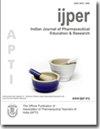Development, Evaluation, and in vitro Anti-Acne Activity of Tretinoin Nanocrystals Gel
IF 0.8
4区 医学
Q3 EDUCATION, SCIENTIFIC DISCIPLINES
Indian Journal of Pharmaceutical Education and Research
Pub Date : 2023-10-04
DOI:10.5530/ijper.57.4.114
引用次数: 0
Abstract
Abstract: Background: Tretinoin is generally used to treat acne vulgaris and photoaging. The study aimed to develop a gel composition containing tretinoin nanocrystals and characterize and compare in vitro anti-acne activity. Materials and Methods: The anti-solvent precipitation approach was used to prepare tretinoin nanocrystals. The drug nanocrystals were optimized for parameters such as particle size, drug content, and drug release. The optimized nanocrystals (TN9) were incorporated into the gel system (TNG1-TNG5) and characterized for pharmaceutical properties. The selected formulation (TNG1) was tested for anti-acne activity using Propionibacterium acnes and Staphylococcus epidermidis and compared with Doxycycline HCl as standard. Results: Nanocrystals (TN9) showed the lowest particle size of 114.2 nm, the least value of polydispersity of 0.232, the highest drug content of 95.24%, and higher cumulative drug release of 97.2% in 10 hr. TEM and DSC images conformed to the nano-size range and crystalline nature of nanocrystals. The prepared gel composition indicates a clear, smooth, and homogeneous nature, good spreadability, suitable viscosity, pH, and drug content. The drug release from TNG1 was found to be significant (p < 0.0001) and was superior to the commercial gel. Results of anti-acne activity signify that the zone of inhibition exhibited by tretinoin nanocrystals was comparable with Doxycycline HCl (standard) for both microorganisms tested. Conclusion: These results demonstrated that the developed tretinoin nanocrystals could be a feasible approach for effective therapy in the treatment of acne. Keywords: Tretinoin, Nanocrystals, Gel, Drug release, Anti-acne activity, Propionibacterium acnes, Staphylococcus epidermidis.维甲酸纳米晶体凝胶的开发、评价及体外抗痤疮活性
摘要:背景:维甲酸被广泛用于治疗寻常性痤疮和光老化。本研究旨在开发一种含有维甲酸纳米晶体的凝胶组合物,并对其体外抗痤疮活性进行表征和比较。材料与方法:采用反溶剂沉淀法制备维甲酸纳米晶体。对药物纳米晶的粒径、药物含量、药物释放等参数进行了优化。将优化后的纳米晶体(TN9)纳入凝胶体系(TNG1-TNG5),并对其进行了药物性能表征。以痤疮丙酸杆菌和表皮葡萄球菌为对照,以盐酸多西环素为对照,对所选制剂(TNG1)进行抗痤疮活性试验。结果:纳米晶(TN9)粒径最小,为114.2 nm,多分散度最小,为0.232,药物含量最高,为95.24%,10 h累积释药率为97.2%。TEM和DSC图像符合纳米晶体的纳米尺寸范围和晶体性质。所制备的凝胶组合物具有透明、光滑和均匀的性质,良好的涂抹性,合适的粘度、pH和药物含量。发现TNG1的药物释放显著(p < 0.0001),优于商业凝胶。抗痤疮活性结果表明,维甲酸纳米晶体对两种微生物的抑制范围与盐酸多西环素(标准)相当。结论:制备的维甲酸纳米晶体是治疗痤疮的有效途径。关键词:维甲酸,纳米晶体,凝胶,药物释放,抗痤疮活性,痤疮丙酸杆菌,表皮葡萄球菌
本文章由计算机程序翻译,如有差异,请以英文原文为准。
求助全文
约1分钟内获得全文
求助全文
来源期刊
CiteScore
1.40
自引率
0.00%
发文量
227
审稿时长
>12 weeks
期刊介绍:
The official journal of Association of Pharmaceutical Teachers of India (APTI) and is being published since 1967. IJPER, a quarterly publication devoted to publish reviews and research articles in pharmacy and the related disciplines of Pharmaceutical education. It mainly covers the articles of special interest, covering the areas of Pharmaceutical research, teaching and learning, laboratory innovations, education technology, curriculum design, examination reforms, training and other related issues. It encourages debates and discussions on the issues of vital importance to Pharmaceutical education and research. The goal of the journal is to provide the quality publications and publish most important research and review articles in the field of drug development and pharmaceutical education. It is circulated and referred by more than 6000 teachers, 40,000 students and over 1000 professionals working in Pharmaceutical industries, Regulatory departments, hospitals etc.

 求助内容:
求助内容: 应助结果提醒方式:
应助结果提醒方式:


